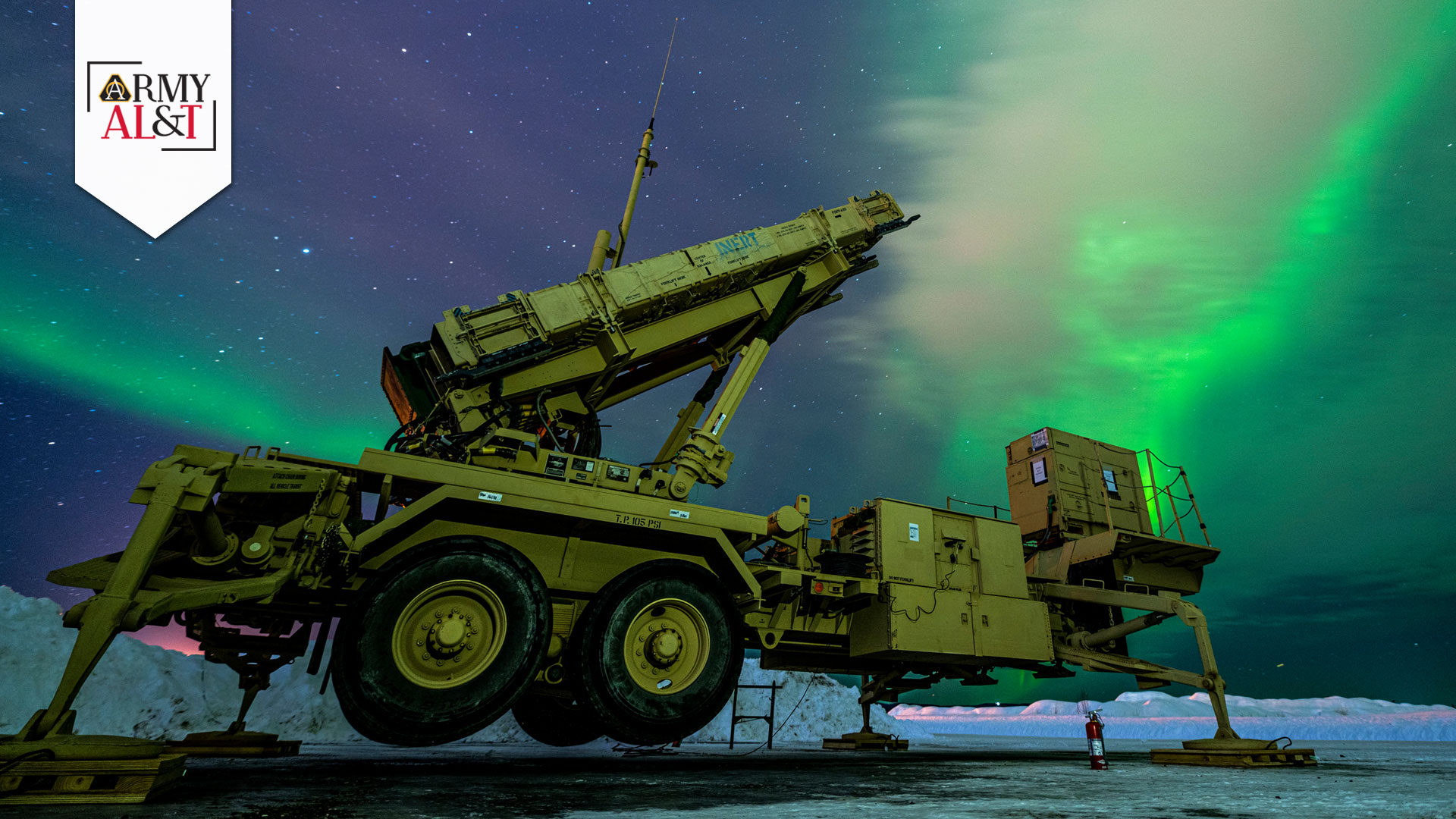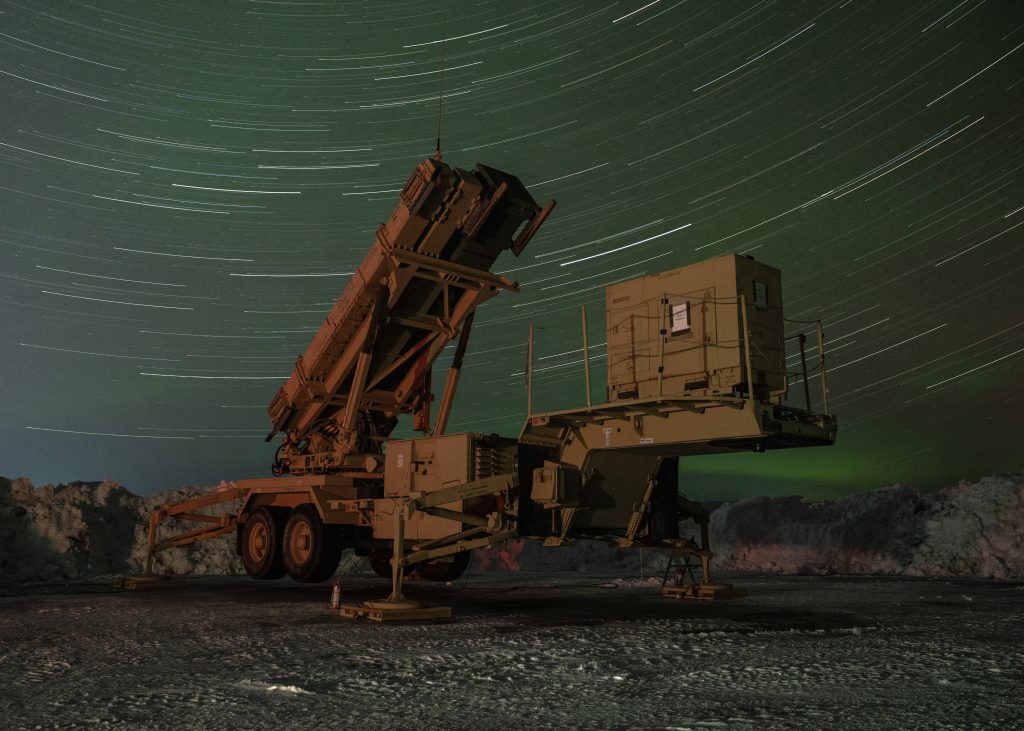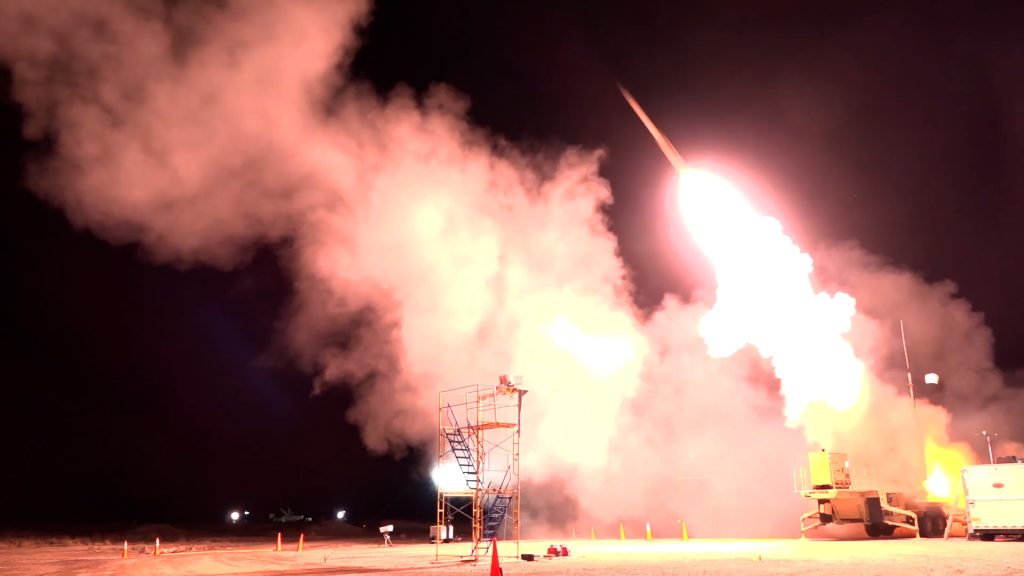
EXTRA SENSORS PERCEPTION: The northern lights glow behind a Patriot M903 launcher station during Exercise ARCTIC EDGE 2022 at Eielson Air Force Base, Alaska, in March. Lower-Tier Air and Missile Defense Sensor replaces the aging Patriot radar to intercept more complex and distant threats. (Photo by Senior Airman Joseph P. LeVeille, U.S. Air Force)
Major transitions in acquisition are often fraught, but the Lower-Tier Air and Missile Defense Sensor team faces new challenges planning the transition of a rapidly prototyped mid-tier acquisition to a major-capability acquisition. Here’s how.
by Maj. David Yi and Capt. (P) William Woolsey
The Army has long operated under the assumption of superiority in the air and space operations. Troops on the ground could focus on the ground fight, because of the superiority of our air and missile defense systems. That assumption is challenged by the escalation of great power competition and the rapid advancement in aviation and missile technology.
The rapid increase in complexity has made it difficult for fielded radar systems to counter threats. The lower-tier air and missile defense sensor (LTAMDS) is a radar intended to improve the air and missile defense battlespace providing networked sensing and a greater ability to search, track and discriminate targets. The radar will act as the eyes and ears of the Army integrated air and missile defense, providing data for a network of launchers to intercept threats.
Detecting threats from a greater range increases the ability to intercept more complicated threats. The need for this capability was compelling enough for Congress require its development. The National Defense Authorization Act for Fiscal Year 2018 mandated an initial operating capability of a 360-degree radar by December 31, 2023. Raytheon was selected to build six prototype radars to support an urgent material release.
Traditional acquisition programs do not support development of a system in such a compressed period. The urgent material release is necessary to address the Congressional identification of military capability gaps between our current capability and the emerging threats. Congress also authorized alternative, rapid-acquisition pathways to provide our warfighters the latest technology to keep up with emerging threats.
Rapid-prototyping authority under the mid-tier acquisition pathway allows the program to move fast to delivery capability. In addition to providing a needed capability, the new radar will replace the legacy Patriot radar; a fielded system that has served the Army since 1981. The legacy Patriot AN/MPQ-65A legacy system is used to defend against ballistic and cruise missiles, manned and unmanned aircraft, and emerging future threats in the lower atmosphere portion of the air and missile defense battlespace—the lower tier. This system has served the military well, but the Patriot radar is starting to show its age.
APPLES BECOME ORANGES
In addition to its limitations in capability, operations and sustainment costs are growing for this dated technology. Production, fielding, and sustainment of a modern radar must not be delayed. These activities are not included in rapid prototyping, and that means that the program must transition into a Milestone C decision under the major-capability acquisition pathway. The Defense Acquisition University defines a traditional major-capability acquisition, as one that is “used to acquire and modernize military unique programs” that follows a structured process.
In February of 2022, the radar’s acquisition strategy received approval from the Army acquisition executive to transition from a mid-tier acquisition to a major-capability acquisition program. The acquisition strategy addresses the need to deliver a capability through rapid prototyping and field a system to replace the aging legacy radar system.
In the Army acquisition process, milestone decision reviews exist for an acquisition program to graduate from concept, prototyping, testing, and ultimately production. The milestone-decision reviews require significant amounts of documentation to support the milestone reviewer that grants the program permission to proceed. In a traditional major-capability acquisition program, data is gathered through each phase and milestone to mature supporting documentation. Traditionally this process takes years, and by the time a system is fielded to the warfighter, it may already be technologically obsolete. This process however is necessary to ensure a program is mature before going into full-rate production and fielded to the operational force.

FULL CIRCLE: Stars and the northern lights illuminate a Patriot missile launcher at a training at Eielson Air Force Base, Alaska, March 4. The new Lower-Tier Air and Missile Defense Sensor will help fulfill Congress’s priority with 360-degree networked radar coverage. (U.S. Air Force photo illustration by Staff Sgt. Dylan Murakami)
FORGING A NEW ACQUISITION PATHWAY
“That briefs well” often describes a task when execution is likely more difficult than it sounds. The new radar’s acquisition strategy certainly briefs well; however, the radar will be one of the first Army programs to transition from the mid-tier acquisition directly into major-capability acquisition at Milestone C. Milestone C is a big transition, when the program can enter into manufacturing and production.
The mid-tier acquisition pathway that allows a program to move quickly does not require the completion of previous milestones. Mid-tier acquisition programs prioritize delivery of capability at the tradeoff of some bureaucracy and risk. The dynamic nature of a prototyping effort means that the standard procedures for developing documentation to support a Milestone C decision are not available. Data received from prototyping efforts inform key documentation, but traditional staffing timelines do not support this. DOD Instruction 5000.02, Operation of the Adaptive Acquisition Framework, lays out opportunities to tailor documentation, reducing the bureaucratic paperwork required to pass milestone decision reviews, making the process seem relatively straightforward.
The tailoring processes is an acknowledgement that documentation will not be available or mature at milestone reviews. However, the reality is that the product office in charge of the radar acquisition will face resistance to the deviation from the norm by stakeholder gatekeepers who own a supporting document. The approach to tailoring must be deliberate, with careful consideration of the interdependencies. Closing the gap requires a deliberate approach and active leadership.

A battery assigned to 1st Battalion, 1st Air Defense Artillery Regiment, display their patriot radar and antenna mast group during table gunnery training exercise on Kadena Air Base in Japan, Oct. 19, 2017. (U.S. Army Photo by Capt. Adan Cazarez)
MILESTONE C TEAM
The product office established a working group to determine the documentation and processes necessary to enter into Milestone C. One key objective was to streamline the process and best tailor required documentation. In support of this objective, the working group collaborated on a master schedule to identify the various dependencies to track and link urgent material release activities to Milestone C documentation.
All working group members have responsibilities in the rapid prototyping program. Intimate familiarity with the program enables the team to identify opportunities for tailoring that are not specified in any regulation or policy. Subject matter understanding facilitates the product office to tailor documents to transition to a follow-up major-capability acquisition program. Data from testing the prototype radars are key to the development of milestone c documents. The firsthand knowledge of the process for testing prototype capability and collecting data informs the strategy for Milestone C documentation. Accurate predictions of when documentation is mature helps members of the Milestone C team to tailor documentation.
A RAND report on tailoring the acquisition process identified that omitting or reducing documents is possible but faces institutional resistance, and that stakeholder agreement is necessary to tailor documents. The product office identified and is reaching out to document stakeholders for concurrence before staffing, thereby addressing the challenges identified in the RAND report of tailoring and the necessity for senior leader concurrence. A best practice is to report tailoring candidates in the acquisition strategy report for review by the milestone reviewer. If the milestone reviewer agrees with the acquisition strategy to tailor the specified documents then it provides top cover for the product office as the tailoring strategy is socialized to stakeholders.
RAPID PROTOTYPING INFORMS REQUIREMENT
Successful entrance into Milestone C will depend on prototyping activities. The activities include developmental testing and evaluation, road mobility, environmental testing, and even an operational test of the radar to determine if the radar’s performance fulfills the requirements. The radar’s performance is then analyzed and documented to support the transition to Milestone C. The production and testing of the radar prototypes will provide critical data to support the Milestone C decision and transition into a major-capability acquisition program.
In the transition plan, the prototypes act as a proof of principle; with the expectation that they will provide a residual operating capability after an operational assessment is complete. In a standard acquisition pathway, requirements are well defined by the time prototypes are produced. With newer technology, it is difficult to predict system capabilities. The capabilities demonstrated in the radar prototypes will inform an updated radar-capability development document. The capability-development document is critical for a Milestone C transition, being heavily referenced by other Milestone C documents.
A challenge with this radar’s acquisition pathway is that staffing these documents begins before capabilities are fully developed and understood as the testing has not been completed yet. In a manufacturing process, this would be akin to changing the design of a key component after production has already started. Without careful planning, this could lead to delays and affect the entire system. Foreseeing and preventing adverse impacts will require careful proactive management of this process; this is only possible through active stakeholder management and engaged leadership.
STAKEHOLDER MANAGEMENT
With the development of a new system, it is not easy to forecast when prototypes will be available to support test events. The radar’s success is not possible without exceptional support, cooperation and flexibility from all stakeholders. This concept has proven itself through the development of the radar’s test plan. Leaders regularly engaged with various community members to ensure resources were coordinated and reserved for testing by the White Sands Missile Range team, targeting support from the United States Army Space and Missile Defense Command, and the Office of the Director of Operational Test and Evaluation.
Engagement with the Air and Missile Defense Cross-Functional Team and the Army capability manager – Army Air and Missile Defense Command will remain critical as the capability development document is defined. Communicating early and often, helps manage stakeholder expectations about capabilities. The radar has incorporated multiple Soldier engagements and training events to solicit feedback on the system’s design. For example, Soldiers’ experience and feedback drove the design change to the primary array’s stowage locks to prevent damage during transportation. Collaboration among user representatives, industry, and government experts allows for assessing the radar’s capabilities from an operational perspective. The operational perspective then informs the development of a concept of operations that fits the radar into the greater Army integrated air and missile defense system of systems architecture.

NIGHT FLIGHT: A flight test of the Terminal High Altitude Area Defense weapon system in March. The test integrated with and fired two Patriot Advanced Capability-3 Missile Segment Enhanced interceptors. The mid-tier acquisition pathway helped rapidly develop prototype sensors. (Missile Defense Agency photo)
SYSTEM-OF-SYSTEMS DYNAMIC
The radar will operate as a “sensor on the net” supporting the Army’s integrated air and missile defense command-and-control structure with other sensors and shooters to provide an “any sensor, best shooter” approach. This unique construct requires coordination with all stakeholders, including user representatives of multiple project offices, to determine how the Army will develop and employ the system.
The radar’s integration into the Army’s integrated air and missile defense system-of-systems allows convergent development paths with associated air and missile defense systems. In this case, rapid prototyping informs requirements, leveraging prototypes to assess how to field, sustain and fight with the Lower-Tier Air and Missile Defense Sensor as a component of the Army Integrated Air and Missile Defense System of Systems.
This is what enables the radar to function as a network sensor. That means that the command-and-control structure commands any connected surface-to-air missile launchers and sensors. Access to multiple radars provides a better picture and increased defended range and coverage for our warfighters. With that information, the best launcher defeats the threat. The term often used to describe this is “any sensor, best shooter” highlighting the advantage a network of sensors and launchers has over the legacy system’s limited network.
The radar acquisition team collaborates with other project offices and industry partners to align the complex system-of-systems requirements to integrate the radar’s capabilities with the holistic Army integrated air and missile defense system of systems capabilities. The effectiveness of the system of systems is assessed within the program executive office missiles and space’s integrated-fires test campaign, which demonstrates capabilities resulting from the concerted effort of four program offices, industry partners and supporting agencies and organizations. The integrated-fires test campaign is the culminating test event where the program executive office missiles and space systems test and operate in a system of systems configuration and demonstrate the Army integrated air and missile defense concept.
| INTEGRATED AIR AND MISSILE DEFENSE BATTLE COMMAND SYSTEM
The Project Office for Integrated Fires Mission Command’s Integrated Air and Missile Defense Battle Command System serves as the command-and-control system in the Army Integrated Air and Missile Defense Architecture and links all the individual components to provide a common operating air picture. The command-and-control system is responsible for integration and compatibility with all subsystems, including the lower-tier air and missile defense sensor, legacy radars and launchers, Sentinel, indirect-fire protection capability, and Link 16.The user community and the Program Executive Office for Missiles and Space direct the software planning priorities to deliver the required capabilities as needed; this is no small feat and requires constant leadership communication, reprioritization, and adjustment to meet the individual subsystems’ mandates or delivery dates. For example, at the worker bee level, the lower-tier air and missile defense sensor product office works with the indirect-fire protection capability team from to identify resource conflicts and collaborates in a joint system engineering integration and test working groups to prioritize the limited programming resources to support development, test and fielding timelines. |
CONCLUSION
The Lower-Tier Air and Missile Defense Sensor is the next-generation radar within the emerging Army Integrated air and Missile Defense Architecture that will replace the Army’s legacy radar, provide more air and missile defense coverage, and exploit the full capabilities of the Patriot Advanced Capability – 3 Missile Segment Enhancement. To deliver capability to the warfighter faster, the Army chose the mid-tier acquisition pathway to field the latest state of the art technology in an aggressive timeline.
Success requires that senior leadership accept, proactively manage, and mitigate risk to support the adaptive acquisition process. Leaders must have a realistic assessment of system capabilities and limitations, understand performance tradeoffs and effectively articulate it to all stakeholders. Failure to communicate and collaborate effectively with all stakeholders can be detrimental to the success of any program, especially one that is executing a rapid prototyping effort while simultaneously working toward the transition to a major-capability acquisition.
Developing a modernized digital radar system that incorporates new technology to meet Army requirements is an impressive feat. It is possible because of tireless efforts and collaboration between stakeholders to design a system with significant capability for our warfighters. The Lower-Tier Air and Missile Defense Sensor will push boundaries as a radar. The program management associated with such a technological achievement should also push boundaries. The acquisition processes should not hinder the delivery of systems that help us fight and win.
For more information, go to https://msl.army.mil/Pages/STARE/default.html.
MAJ. DAVID YI is an assistant product manager of the PM Search Track Acquire Radiate Eliminate, PEO Missiles and Space, Huntsville, Alabama. He holds an M.S. in systems engineering management from the Naval Postgraduate School, an M.A. in leadership studies from the University of Texas at El Paso, and an undergraduate degree in business management from Florida International University. He is a former infantry and air defense artillery Army officer.
CAPT. (P) WILLIAM WOOLSEY is an assistant product manager of the PM Search Track Acquire Radiate Eliminate, PEO Missiles and Space in Huntsville, Alabama. He holds a B.S. in business administration from The Citadel in South Carolina. He is an Army acquisition officer and a former financial management officer.







